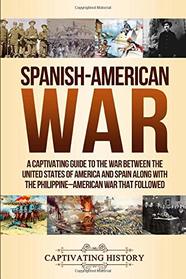At the close of the 1890s, America was trying out their muscle in the world at large and took part in two wars in quick succession. The first war was with Spain, lasting a mere 10-weeks. Ostensibly the war was to help the Cubans earn independence, but imperialistic dreams were part of the equation for some Americans. One of the reasons for the rush to weapons was the fact that the North and South needed a common enemy, to finally put the Civil War behind the country.
The Cubans had been fighting unsuccessfully for independence for a long time and America was watching. Yellow journalism reared its ugly head during these years, hoping to sell more newspapers. What they learned was that they could manipulate opinion far enough to bring about war.
It was nice to read the real story of the Rough Riders; and interesting to learn how important the Buffalo Soldiers were to their success. Once the war was over, the peace treaty took longer to forge than the war. However, one problem with that accord was the fact that no representatives (Cubans or Filipinos, for example) from the affected countries were allowed to participate. When the Americans disregarded the sovereignty of the Filipinos, the rebels turned on the Americans and started the Philippine-American War (2/4/1899 to 7/2/1902).
After reading this combined history of American imperialism in the 1890-1902 era, it is not surprising that there was so little information on these two conflicts in our history books. It is a really ugly picture.
The Philippines must have been a difficult enemy for a number of reasons. The Philippines are a group of some 7600 islands, speak 89 distinct dialects and those islands are spread out (north to south) over 1200 miles. The Filipinos had been trying to wrest independence from Spain for some 300 years and were enraged to find the Americans planning their future for them instead of giving them freedom.
The shocking thing about the 3+ years of fighting is that 34,000 Filipino soldiers died but between 200,000 and 1 million civilians died, mostly by starving and disease. The US saw the Filipinos as racially inferior savages. This country remained a possession of the US until after WW II because the government knew it would be unpopular in the US to admit more 'dark-skinned people' to the Union.
One of the upshots of the Philippine-American War was that the US government was hesitant to join in future conflicts (namely, WWI and WWII) because of the difficulties in this war.
My only disappointment with this book was the insertion of the My Lai Massacre of March 1968 (page 214). It didn't further the story and was just heaping disgust on top of the abhorrence the reader was already feeling from the Filipino War.
On the other hand, I wish to thank the author for this pair of history lessons. Americans need to read more about their history, from other sources than school texts. I can assure you that I didn't learn anything like what is shared in this book.
The Cubans had been fighting unsuccessfully for independence for a long time and America was watching. Yellow journalism reared its ugly head during these years, hoping to sell more newspapers. What they learned was that they could manipulate opinion far enough to bring about war.
It was nice to read the real story of the Rough Riders; and interesting to learn how important the Buffalo Soldiers were to their success. Once the war was over, the peace treaty took longer to forge than the war. However, one problem with that accord was the fact that no representatives (Cubans or Filipinos, for example) from the affected countries were allowed to participate. When the Americans disregarded the sovereignty of the Filipinos, the rebels turned on the Americans and started the Philippine-American War (2/4/1899 to 7/2/1902).
After reading this combined history of American imperialism in the 1890-1902 era, it is not surprising that there was so little information on these two conflicts in our history books. It is a really ugly picture.
The Philippines must have been a difficult enemy for a number of reasons. The Philippines are a group of some 7600 islands, speak 89 distinct dialects and those islands are spread out (north to south) over 1200 miles. The Filipinos had been trying to wrest independence from Spain for some 300 years and were enraged to find the Americans planning their future for them instead of giving them freedom.
The shocking thing about the 3+ years of fighting is that 34,000 Filipino soldiers died but between 200,000 and 1 million civilians died, mostly by starving and disease. The US saw the Filipinos as racially inferior savages. This country remained a possession of the US until after WW II because the government knew it would be unpopular in the US to admit more 'dark-skinned people' to the Union.
One of the upshots of the Philippine-American War was that the US government was hesitant to join in future conflicts (namely, WWI and WWII) because of the difficulties in this war.
My only disappointment with this book was the insertion of the My Lai Massacre of March 1968 (page 214). It didn't further the story and was just heaping disgust on top of the abhorrence the reader was already feeling from the Filipino War.
On the other hand, I wish to thank the author for this pair of history lessons. Americans need to read more about their history, from other sources than school texts. I can assure you that I didn't learn anything like what is shared in this book.




